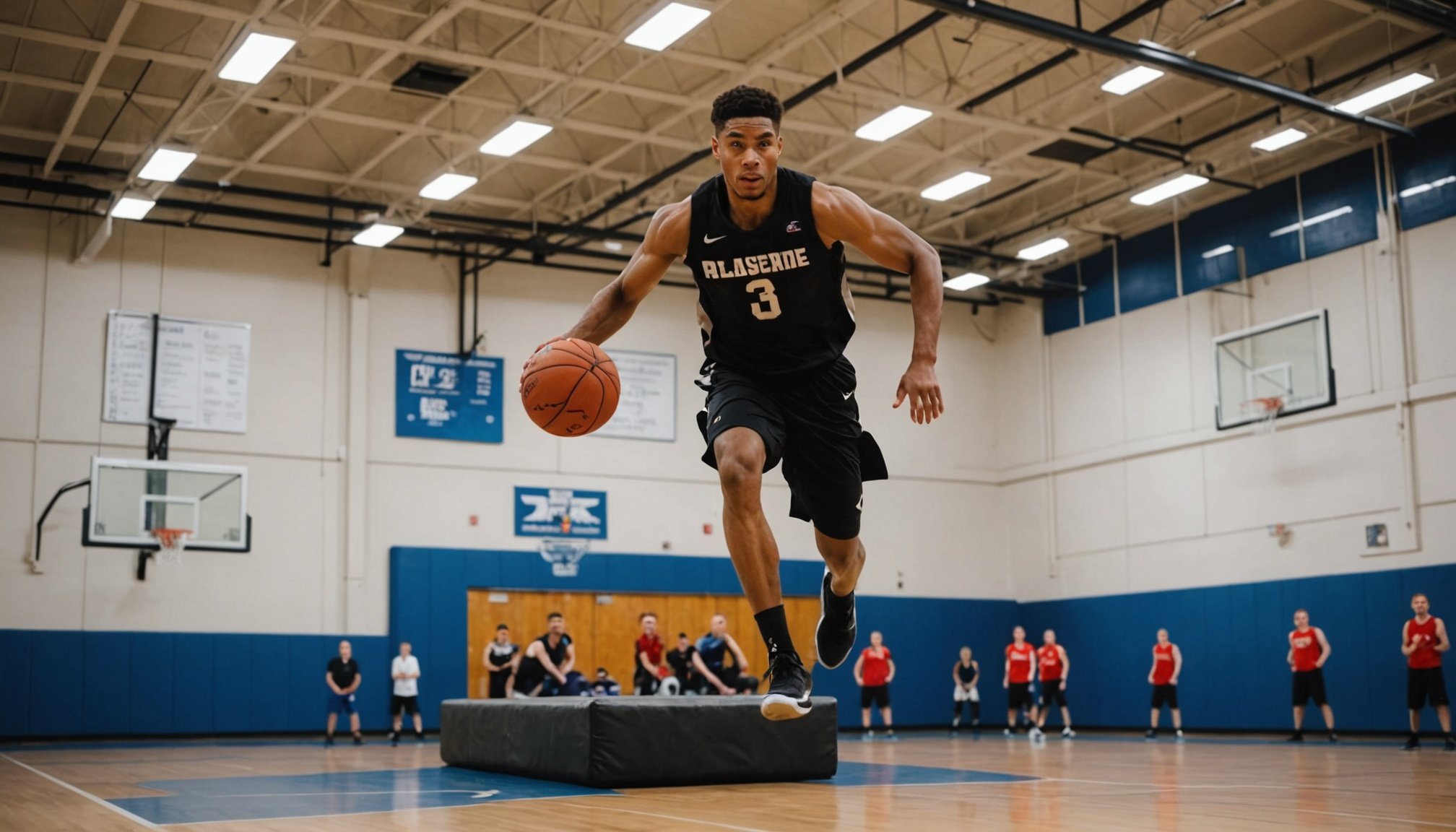Overview of Plyometric Training
Plyometric training is critical for basketball centres aiming to enhance their explosive power. This specific type of training involves exercises that enable muscles to exert maximum force in short intervals, boosting athletic performance.
For basketball players, particularly centres, incorporating plyometric exercises is pivotal. Explosive power directly impacts their on-court performance by improving their ability to leap higher for rebounds, execute powerful dunks, and quickly change direction on defense. Activities such as box jumps, depth jumps, and medicine ball throws are examples of plyometric exercises that focus on fast, powerful movements.
Also to discover : Top Defensive Drills Every UK Basketball Team Should Master for Success
When integrating plyometrics into a training regimen, it’s essential to adhere to some general guidelines:
- Begin with a proper warm-up to prevent injuries and prepare the muscles for high-intensity movements.
- Start with lower intensity exercises, gradually increasing the intensity as the player’s strength and conditioning improve.
- Ensure adequate recovery between sessions to allow muscles to repair and grow stronger.
Incorporating plyometric training not only enhances explosive power but also overall basketball performance, making it an indispensable part of a centre’s training program.
Also read : How can a player effectively transition from college basketball to the professional level?
Key Plyometric Exercises for Basketball Centers
Plyometric exercises are essential in enhancing a basketball center’s performance, emphasising explosive power and agility.
Box Jumps
Box jumps involve leaping onto a stable surface like a box, aiding in boosting vertical leap and explosive strength—key components for dominating the court. Opt for a box height that challenges but doesn’t risk injury, typically starting at knee height. As jumping skills improve, gradually increase the box height, ensuring a steady progression.
Depth Jumps
This exercise involves stepping off a box, followed by an immediate upward leap upon ground contact. Depth jumps focus on reactive strength and significantly enhance power output. It’s crucial to perfect landing techniques—soft knees and balanced stance—to prevent injury and maximise benefits.
Medicine Ball Slams
Medicine ball slams, emphasising full-body involvement, bolster core strength and overall power generation. Practise by raising the ball overhead before slamming it down forcefully. Vary this exercise by adjusting ball weight and incorporating rotational throws. Include this in your routine 2-3 times weekly.
Tuck Jumps
Tuck jumps demand advanced agility and explosiveness. Jump upwards, drawing knees to the chest mid-air. Ensuring quick feet landing minimises impact, safeguarding joints. For a less intense version, consider squat jumps to build foundational strength gradually.
Benefits of Plyometric Workouts
Plyometric workouts offer an array of benefits, especially for basketball centers who need to excel in rebounding. One of the key benefits of plyometrics is the significant increase in vertical jump height. By consistently engaging in these exercises, athletes can elevate their performance, making it easier to reach higher for rebounds. This is essential because a higher vertical jump directly translates to more successful rebounding, a crucial skill for positions in the center.
Moreover, plyometrics enhance both speed and agility. For basketball centers, improving on-court mobility means being quicker on their feet, which is vital for both offensive maneuvers and defensive positioning. These enhancements collectively give players a competitive edge during games, allowing for swifter transitions and more effective plays.
The long-term advantages of consistent plyometric training cannot be overstated. These workouts contribute not only to physical development but also to injury prevention. By building stronger muscles and joints, athletes can maintain peak performance levels while reducing the risk of common sports injuries. Over time, this leads to sustainable performance enhancement, allowing basketball centers to maintain their athleticism throughout their careers.
Tips for Proper Form and Safety
Engaging in plyometric exercises can be thrilling and rewarding, but maintaining proper form is crucial to ensure injury prevention. Before jumping into the intense routine, always begin with a thorough warm-up. This should include dynamic stretches to increase blood flow and prepare your muscles for the physical demands ahead.
It’s also vital to include a cool-down routine, which can prevent muscle stiffness and aid recovery. This generally involves static stretching and gradually lowers your heart rate.
Avoid common mistakes that compromise safety. One error is neglecting alignment; always keep your knees soft and avoid letting them cave inward during jumps. This can strain your joints. Additionally, control your landings to prevent undue stress on your body.
Monitoring the intensity and volume is essential. Start with low intensity and gradually increase. Pay attention to your body’s signals. Avoid doing too much, too soon, to reduce the risk of injury.
Remember, the quality of your movement matters more than quantity. By following these safety tips, you can enjoy an effective workout while ensuring your body’s welfare.
Recommended Training Frequency and Progressions
Balancing training frequency and adequate rest is critical for basketball training success. To optimize results, it’s crucial to follow a structured plan. For beginners, starting with plyometric workouts twice a week is recommended. This provides sufficient stimulus for improvement while allowing the body to adapt.
Recovery time is indispensable in any training regimen. Adequate rest prevents overuse injuries and enhances performance by allowing muscles to repair and strengthen. Incorporating rest days, ideally between intense sessions, ensures that the body can recover fully, maintaining peak performance levels.
Workout progressions are vital as athletes advance in their training. For experienced individuals, increasing the frequency to three times a week may be beneficial. It’s essential to adjust intensity and volume gradually to ensure continued improvement without risking injury.
Athlete experience levels significantly affect how training progressions should be structured. Novices benefit from focusing on technique and consistency, while seasoned athletes might incorporate more complex and sport-specific drills. Recognizing these stages allows tailored progressions that align with individual needs, ensuring effective and safe development.
Overall, a strategic approach to frequency and progression maximizes potential while minimizing risk, fostering long-term athletic growth.
Equipment Needed for Effective Plyometric Training
Selecting the right plyometric training equipment is pivotal for maximising performance and reducing injury risks. For athletes, certain essential gear can significantly enhance the impact of their workouts.
Start with jump boxes, a fundamental piece for building explosive leg power. Adjustable height settings offer versatility. Next, resistance bands assist in engaging different muscle groups, providing both strength and flexibility training.
Balance trainers such as Bosu balls, often underrated, are crucial for improving stability and coordination, vital components of effective plyometric exercises.
For those seeking cost-effective options, a skipping rope offers affordability and accessibility while delivering cardiovascular benefits and footwork agility. Training in outdoor spaces or utilising gym facilities can also broaden one’s options for training aids. Open spaces facilitate hurdle drills or running sprints, while gyms provide structured environments with the necessary safety measures and equipment like free weights or medicine balls for strength enhancement.
Choose equipment that aligns with your fitness goals and adaptability in various settings. This approach ensures a well-rounded, efficient training programme that can be tailored to individual needs, exploiting available resources.
Resources and Training Facilities in the UK
Exploring the options for enhancing basketball skills, the UK offers a variety of training facilities tailored for aspiring basketball centers. Many reputable sports facilities provide specialised plyometric training, essential for developing explosive strength and agility. These facilities often integrate cutting-edge technology and expert coaching to maximise an athlete’s potential.
At these UK training facilities, players can enrol in specific programs designed to improve their performance. Programs might include plyometric training, intended to enhance jumping and speed, which are crucial for basketball training centers. Furthermore, many of these facilities offer personalised coaching plans to cater to individual needs.
Beyond facilities, community resources play a pivotal role in providing ongoing education. Numerous local initiatives and classes focus on strength training and plyometrics. These community resources create an environment where athletes can continuously update and refine their techniques.
For those committed to excelling in basketball, harnessing the potential of these UK resources is critical. By leveraging both state-of-the-art facilities and community support, players can ensure well-rounded development and competitive readiness.











